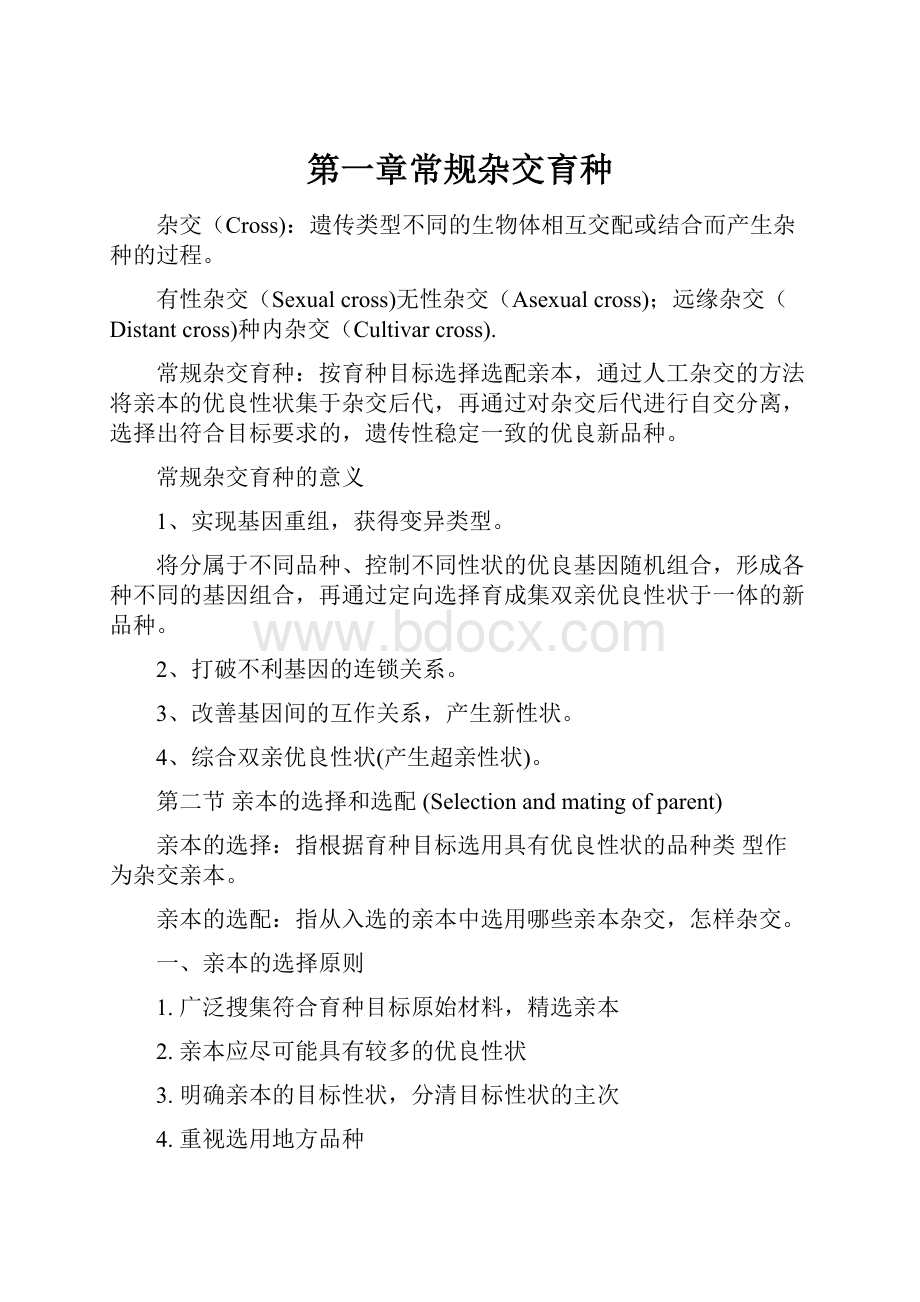第一章常规杂交育种.docx
《第一章常规杂交育种.docx》由会员分享,可在线阅读,更多相关《第一章常规杂交育种.docx(12页珍藏版)》请在冰豆网上搜索。

第一章常规杂交育种
杂交(Cross):
遗传类型不同的生物体相互交配或结合而产生杂种的过程。
有性杂交(Sexualcross)无性杂交(Asexualcross);远缘杂交(Distantcross)种内杂交(Cultivarcross).
常规杂交育种:
按育种目标选择选配亲本,通过人工杂交的方法将亲本的优良性状集于杂交后代,再通过对杂交后代进行自交分离,选择出符合目标要求的,遗传性稳定一致的优良新品种。
常规杂交育种的意义
1、实现基因重组,获得变异类型。
将分属于不同品种、控制不同性状的优良基因随机组合,形成各种不同的基因组合,再通过定向选择育成集双亲优良性状于一体的新品种。
2、打破不利基因的连锁关系。
3、改善基因间的互作关系,产生新性状。
4、综合双亲优良性状(产生超亲性状)。
第二节亲本的选择和选配(Selectionandmatingofparent)
亲本的选择:
指根据育种目标选用具有优良性状的品种类型作为杂交亲本。
亲本的选配:
指从入选的亲本中选用哪些亲本杂交,怎样杂交。
一、亲本的选择原则
1.广泛搜集符合育种目标原始材料,精选亲本
2.亲本应尽可能具有较多的优良性状
3.明确亲本的目标性状,分清目标性状的主次
4.重视选用地方品种
5.亲本的一般配合力要高
二、亲本的选配的原则
1.父母本性状互补
2.选用不同类型或不同地理起源的亲本相配
3.以具有较多优良性状的亲本作母本
4.亲本之一的性状应符合育种目标(Why)
5.用一般配合力要高的亲本配组
第三节杂交方式和技术
1、单交(singlecross)2、多亲杂交(multiplecross)
添加杂交多个亲本逐个参与的杂交。
[(A×B)×C]×D…
合成杂交:
参加杂交的亲本先两两配成单交种,两个单交种再杂交。
(A×B)×(C×D)…
特点:
杂种群体的遗传基础丰富,亲本的核遗传组成均等
3.回交(Backcross)杂交一代及以后各世代与亲本之一再进行杂交。
轮回亲本(recurrentparent):
在回交过程中多次参与杂交的亲本。
非轮回亲本(nonrecurrent/donorparent):
在回交过程中只参加一次杂交的亲本,也叫做“供体”。
二、有性杂交技术(Hybridizationtechniques)
•Forhybridization,raisingofcrop,equipmentrequired,preparationoffemaleflowers,andpollinationaretheimportantaspects.Avegetablebreedershouldhaveaworkingknowledgeofvegetablecropproduction.
•A制定杂交计划;
•B了解育种对象的开花生物学习性;
•C必要的生产资料购置;
•D杂交工具准备。
•Apairoffine-tippedforceps,aspear-pointedneedle,apairofscissors,amagnifyinglens,asmallvialofalcohol,tasselbags,crossingorpollinationbags,ahandstapler,labeltags,electricpollencollector,pollencarrier,andapronarethecommonfacilitiesrequiredinhybridizationprograms.
(一)亲本株的培育和选择
1.种株培育的三项基本要求是:
生长健壮、典型性及无病虫危害。
Beforestartingemasculation,itshouldbeensuredthatalltheplantsofthebreedinglinearetruetothetype.
2.采取各种措施调整亲本花期,使之相遇。
Inordertowidenthehybridizationperiod,multipledatesofplantingmaybeadopted.
3.选择杂交用花应根据不同园艺植物选择适当开花节位或花序,选留数量适中,健壮饱满的花蕾。
Thepropersizeofthebudselectedforemasculationdecidestoagreatextentthesuccessofhybridization.Usuallybudsabouttoopenorduetoopenthefollowingdayareselected.Generally,lowerbudsarebetterthantheterminalbudsforhybridization.
(二)隔离措施
防止非目的性杂交,应采取适当的隔离措施。
通常用半透明羊皮纸或硫酸纸进行花序或单花套袋隔离。
(三)父本花粉采集、贮存和生活力检验Collecting,storageandtestingofpollen
父本花粉应从隔离条件下,亲本株当天盛开花朵上取得。
也可在花前一天取回父本花蕾,取出花药干燥后取粉。
Eitherpolleniscollectedfromtheflowerortheflowerisusedassuchforpollination.Incloudyweatherandatlowtemperature,Pollencollectionisneededforlaterpollination.
(四)母本花去雄授粉(Emasculation)
两性花园艺植物的母本在授粉前必须去除雄蕊以防自交。
去雄可在开花前一天下午进行。
授粉可在去雄后马上进行,也可在第二天开花后进行。
(五)杂交标记与登记
杂交后的花应挂牌标记。
并建立有性杂交登记表。
(六)杂交后的管理
检查纸袋等隔离物;
及时去除隔离物;
加强母本种株的栽培管理。
(七)杂交种子的收获和贮存
1.及时采收;
2.收获过程中严格防止不同杂交组合的错乱和混杂;
3.种子脱落后晒干,装于纸袋内,袋外写明组合名称,袋内放入相应的标签;
4.种子贮存于低温、干燥、防虫、防鼠的条件下。
第四节杂交后代的选择培育
杂交后代的选择
系谱法(pedigreemethod)
混合法(massorbulkselection)
单子传代法(singleseeddescentmethod)
一、系谱选择法的基本程序
1、杂种一代(F1)
以组合为小区种植,每小区30-50株。
F1一般不做选择,按组合混收留种。
2、杂种二代(F2)
将每组合混收的种子按小区种植。
根据目标性状控制基因对数多少计算F2群体大小。
人选的目标株应单株自交留种。
若一对显性基因自交后代出现目标性状的比例为3/4,一对隐性基因自交后代出现目标性状的比例为1/4,则:
具有r对隐性基因,d对显性基因的目标个体在F2出现的比率
(1/4)r×(3/4)d------p
当选出目标株的几率为a时,出现1株目标个体所需种植的株数要满足
(1—p)n〈1—a
则种植株数n≥log(1—a)/log(1—p)
当r和d都为3,选出目标株的几率a为95%
n=log(1—0.95)/log[1—(1/4)3×(3/4)3=451.39(株)
当条件允许时,一般按1000—2000种植
PhaseI:
CreatingInitialVariation
Grow50to100F1plantsinabulkplot
Grow2000to3000F2plants.Selectandharvestplantsorspikesthatseemtocombinedesiredparentalcharacteristics.
3.杂种三代F3:
按F2人选的单株后代(株系)为小区分别播种,每小区50株。
10个小区设一ck,淘汰不良株系,优系中选优株自交,单株留种。
系内高度一致者可升级鉴定。
4.从F4以后,均重复F3工作,优系中选优株自交直致系内纯合一致。
PhaseII:
PedigreeMethod
F3toF5generation:
•Growprogenyrowswithseedharvestedfromsuperiorplantsharvestedinthepreviousgeneration
•Select3to5ofthebestplantswithintheserows
•25to50familiesmayberetainedattheendoftheF5generation
•Identityofplantandrowismaintainedandsuperiortraitsoftheplantsarerecorded
5.品种比较试验
条件一致、三次重复、设置对照(ck),保护行。
人选最佳品系。
6.区域试验(多点试验)
在与品比试验方法相似的基础上,按不同地区多点设置。
一般由省或省级以上品种审定委员会安派,相应级别种子管理部门组织实施。
7.品种审定。
PhaseIII:
PedigreeMethod
F6
•Growfamiliesof1plantinrows
•Selectedseedlotsaredesignatedexperimentallines(EL)
F7
•GrowELtogetherwithadaptedlinesinapreliminaryfieldtrial
F8toF10
•Yieldtrialsarecontinuedattwoorthreeenvironments
F11toF12
•Increaseseedanddistributethenewcultivar
PedigreeMethod
•Mainobjectiveistoisolatesuperior,recombinant,homozygouslines
•SelectionisperformedfromtheF2generationonward
•Responsetoearlygenerationselectionofquantitativetraitsmaybelowbecauseofheterozygosity
PedigreeMethodAdvantages
1.Eliminatesunpromisingmaterialatearlystages
2.Multi-yearrecordsallowgoodoverviewofinheritanceandmoreeffectiveselectionthroughtrialsindifferentenvironments
3.Multiplefamilies(fromdifferentF2individuals)aremaintainedyieldingdifferentgenecombinationswithcommonphenotype
PedigreeMethodDisadvantages
1.Labor,timeandresourceintensive;usuallymustcompromisebetween#crossesandpopulationsizes;
2.Verydependentonskillofbreederinrecognizingpromisingmaterial;
3.Notveryeffectivewithlowh2traits;
4.Slow;canusuallyputthroughonlyonegenerationperyear,andtherightenvironmentalconditionsmustbeathandforaccurateselection.
二、混合法(bulkmethod)
混合法的工作要点
在杂种分离世代,按组合混合种植,除淘汰明显的劣株和杂株外,一般不加选择,直到杂种后代纯合百分率达到80%以上时(约在F5~F8)或在有利于选择时(如病害流行或某种逆境条件如旱害、冻害严重年份)才进行个体(如单株或单穗)选择,下一代种成系统(株系或穗系),然后选拔优良系统升入比较试验。
MassSelectionorBulkMethod
•Aprocedureforinbreedingasegregatingpopulationuntiladesiredlevelofhomozygosityisreached
•Seedusedtogroweachselfedgenerationisasampleoftheseedharvestedinbulkfromthepreviousgeneration.
•SeedsharvestedintheF1throughF4generationsarebulkedwithoutselection
•Selectionisdelayeduntiladvancedgenerations(F5-F8)whenmostsegregationhasstopped.
•Shortterm,timeandlaborsavingpracticalbreedingprocedureforthemanagementofsegregatinggenerationstoattainasufficientlevelofhomozygositypriortoinitiationofindividualplantselection
BulkMethodAdvantages
–Lessrecordkeepingthanpedigreemethod
–Inexpensive
–Easytohandlemorecrosses
–Naturalselectionisprimarilyforcompetitiveability
–Largenumbersofgenotypescanbemaintained
–Canbecarriedonformanyyearswithlittleeffortbythebreeder
BulkMethodDisadvantages
–Lessefficientthanpedigreemethodonhighlyheritabletraits(becausecanpurgeundesirablephenotypesinearlygenerationsofpedigreemethod)
–Notusefulinselectingplanttypesatacompetitivedisadvantage(dwarftypes)
–Finalgenotypesmaybeabletowithstandenvironmentalstress,butmaynotbehighestyielding
–Ifusedwithacrosspollinatedspecies,inbreedingdepressionmaybeaproblem
混合法与系谱法的比较
优点:
1、分离世代群体大,不会丢失优良的基因型;
2、方法简单易行;
3、充分利用自然选择,易获得对生物有利的性状;
4、可能得到育种目标以外的优良类型。
缺点:
1、人工选择与自然选择目标不一致的性状易丢失;
2、未选择,存在许多不良基因类型;
3、杂种后代要求大群体;
4、高代选择工作量大;
5、亲缘关系无法考证。
三、单籽传代法SingleSeedDescentMethod
•SingleSeedDescentprocedureisbasedonadvancinggenerationsthroughsingleseedfromeachplantineachgeneration;
•Thisseparatestheinbreedingphasefromtheselectionphase-reachtheF6generationfaster;
•CarriesforwardmaximumnumberofF2plantstoastagenearhomozygosity;
SingleSeedDescentProcedures
•CrossselectedparentsandproducesufficientF1seed
•GrowenoughF1plantstoproduce1000-2000F2plants
•GrowF2plantsunderconstrainedconditionsthatforceearlymaturityandharvest1seedformeachplant;noobservationsneedtoberecorded
•RepeatthroughapproximatelyF5generation
•SelectsuperiorF6plantsandtestprogenyinreplicatedtrials
•Releasenewvarieties
SingleSeedDescentMethod
SingleSeedDescentMethodAdvantages
1.Rapidgenerationadvance;2-4generations/yr
2.Requireslessspace,timeandresourcesinearlystages,thereforeaccommodateshigher#crosses;
3.Superiortobulk/massselectionifthedesiredgenotypeisatacompetitivedisadvantage;naturalselectionusuallyhaslittleimpactonpopulation
SingleSeedDescent-Disadvantages
1.Maycarryinferiormaterialforward
2.Fewerfieldevaluations,soyoulosetheadvantageofnaturalselection
3.Needappropriatefacilitiestoallowcontrolledenvironmentmanipulationofplantsforrapidseedproductioncycles(daylength,moistureandnutrientcontrol)
单籽传代法的工作要点
自F2开始,每代都保持同样规模的个体,一般为1000-2000株。
从每一株上随机取一粒种子混合组成下一代(F3)群体,如此进行数代,直到纯合化达到要求时(F5或F6),再按株收获,下年种成株行,从中选择优良株行混收,进行产量比较试验。
单籽传代法的优缺点
优点:
1.育种进程快,可缩短育种年限。
2.由于早代不进行选择,可节约土地和人力。
3.尽可能多保持杂种群体的遗传变异多样性。
缺点:
1.要求育种材料的群体性状好。
2.缺少株系间的评定,不利于某些性状的选择。
3.在实际工作中,难以保证每一粒种子都能正常发育,可能导致某些优良基因型的丢失。
四、加速育种进程的方法
1.加速世代繁育进程的方法
异地加代
就地加代
室内加代
2.加速世代繁育进程的主要技术
种子处理
春化处理
光照处理
3.加速试验进程的方法
提早测产
越级试验
多点试验
第一章思考题
1、常规杂交育种的意义。
2、常规杂交育种的杂交方式。
3、常规杂交育种亲本的选择与选配原则。
4、有性杂交技术的操作步骤。
(论述)
5、名词:
常规杂交育种;轮回亲本;非轮回亲本。
6、怎样用系谱法、混合法或单子传代法进行杂交后代的选择。
7、以上三种方法的优缺点如何。
8.加速育种进程的方法主要有哪些。